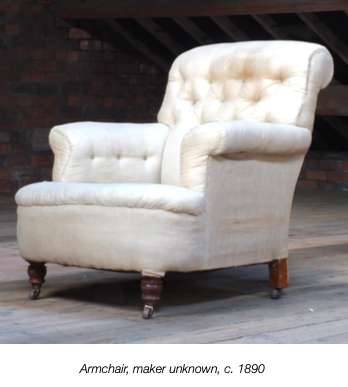History of Upholstery and the roll of the Upholsterer.
The history of upholstered furniture is correlated with the role of the upholsterer.
Upholstery development can be broken down into three phases;
· The build up of technical ability from ancient times to the start of the 18th century,
· The mastery of skill during the 18th century and finally
· Development and modernisation from the 18th century to contemporary day.
The minimisation of the role of the upholsterer was indirectly caused by a reaction to the gradual reduction in the cost of furniture as employers were forced to decrease the cost of labour and materials.
UP TO THE 18TH CENTURY
Upholstery began with a simple, leather covering over a seat in the 16th century. If anything, a cushion would be added for comfort as these allowed for the frames to be easily transported, a priority for noblemen with various properties. By the early 1600s, a down filled cushion had been inbuilt into the frame. However this quickly fell out of shape. Skate stuffing was introduced by 1625, whereby a linen sack cloth was filled with hair and fabric was pulled over the top. Upon the return of Charles I in 1660, elaborate design inspired fuller, more domed upholstery. Backs and arms began to be skate stuffed and the amount of fibre used increased. But there was still a desire for a firmer edge.
Within the 18th century upholstery rapidly advanced. This began with front lipped upholstery. Upholsterers began to encase hair inside a linen, cylindrical dome on the front edge of the frame, creating a lip. The back part of the seat would then be stuffed as normal. This allowed the shape of the seat to be maintained for longer. Next lipped upholstery was introduced, whereby the dome was not just on the front side of the chair, but diverged around the sides too. Seats became deeper and more rigid, but as rounded upholstery became less fashionable, square edged upholstery began to be sought after.
By the middle of the 1700s, bordered upholstery had materialised in two forms. One such technique involved creating a box-like piece of linen (with a top piece and a border, much like what modern day upholsterers would call a box cushion) which would cover the stuffing. Then the hair would be blind stitched at a 45 degree angle in three separate rows. The stitching pulled the hair outwards, creating a firm edge. Alternatively, webbing was fixed to the back of the frame and hooked around extensions of the front legs, acting as the border, which was then stitched in the same way. At this time, reproductions of a square edge were being forged with simply a deep wooden edge to the frame and a skate stuffing over the top.
By the 1790s the fully stitched edge as we know it today had been realised. Upholsterers would blind stitch and then top stitch at least 2 rows. Top stitching, whereby the twine protrudes out of the top of the seat, allowed the hair to be pulled tighter than before. This process was largely unchanged throughout Victorian Eclecticism, Gothic Revival, Arts and Crafts and Art Nouveau, until after the Edwardian era.
UPHOLSTERY FROM 1800’S
By the 1790s and into the 1800’s, the fully stitched edge as we know it today had been realised. Upholsterers would blind stitch and then top stitch at least 2 rows. Top stitching, whereby the twine protrudes out of the top of the seat, allowed the hair to be pulled tighter than before. This process was largely unchanged throughout Victorian Eclecticism, Gothic Revival, Arts and Crafts and Art Nouveau, until after the Edwardian era.
The Victorian obsession for comfort led to the development of the spring in the 19th century. This indirectly caused upholstery to become much fuller, to account for the depth of the springs in the seat. As a result, deep buttoning was implemented. As with many other examples throughout this writing, design was being hugely influenced if not controlled by the materials available.
EARLY 20TH CENTURY
Post 1910 the value of furniture both metaphorically and monetarily decreases. Furniture was no longer for only the wealthy, but for everyone. Although noble in its theory, the indirect result was that manufacturers began to find ways to cheapen the elaborate methods of traditional upholstery to make furniture more available to low income consumers. As a result, upholsterers began to cheat. Coir fibre, a cheaper replacement for hair was more commonly used. There was an influx in the use of waddings such as cotton felt to cover badly stuffed seats or backs. Alternative materials were more regularly used in upholstery. Dug rolls, flat layered springs, rubberised hair and then latex were all new substitutions. Through these introductions, the role of the upholsterer gradually required less precision and skill.
POST WAR TO MODERN DAY
The World Wars initiated standardisation which, combined with new materials, ultimately pushed further towards the decline of skills and the craft workshop. During the war effort, craftsmen utilised for aircraft construction, which required a higher level of reproducible precision. It provided a grounding for manufacturers in mass production which permeated into the furniture industry. As well as this, the lack of timber available at the time fuelled the search for new materials.
POST WAR
Post World War II, new materials began to lead design. Latex as well as rubberised hair began as replacements for old techniques, but by the mid century polyurethane foam and plastics began to formulate the basis of manufacturers designs. Slowly production process reduced in order to allow for replicability. Inflatable furniture, frameless furniture and even furniture that expanded once the consumer opened the box became popular.
MODERN DESIGN
Millennial design has seen further advancements in furniture manufacture with the advent of 3D CAD and 3D printing. Public understanding of industrialisation has been redefined as it is no longer necessarily associated with low quality factory furniture, but technology is able to produce furniture to the same standard.
BY LIBBY PAYNE
UPHOLSTERER @ LAWSON WOOD











